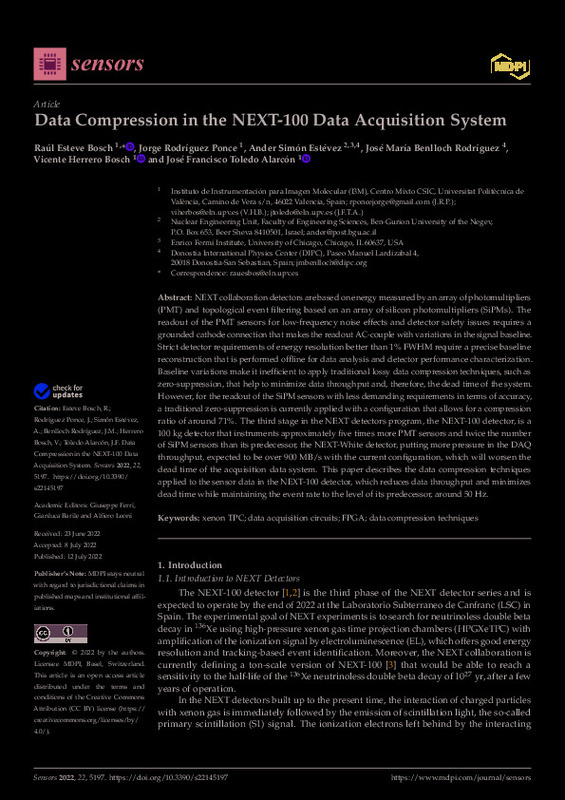|
Resumen:
|
[EN] NEXT collaboration detectors are based on energy measured by an array of photomultipliers (PMT) and topological event filtering based on an array of silicon photomultipliers (SiPMs). The readout of the PMT sensors for ...[+]
[EN] NEXT collaboration detectors are based on energy measured by an array of photomultipliers (PMT) and topological event filtering based on an array of silicon photomultipliers (SiPMs). The readout of the PMT sensors for low-frequency noise effects and detector safety issues requires a grounded cathode connection that makes the readout AC-couple with variations in the signal baseline. Strict detector requirements of energy resolution better than 1% FWHM require a precise baseline reconstruction that is performed offline for data analysis and detector performance characterization. Baseline variations make it inefficient to apply traditional lossy data compression techniques, such as zero-suppression, that help to minimize data throughput and, therefore, the dead time of the system. However, for the readout of the SiPM sensors with less demanding requirements in terms of accuracy, a traditional zero-suppression is currently applied with a configuration that allows for a compression ratio of around 71%. The third stage in the NEXT detectors program, the NEXT-100 detector, is a 100 kg detector that instruments approximately five times more PMT sensors and twice the number of SiPM sensors than its predecessor, the NEXT-White detector, putting more pressure in the DAQ throughput, expected to be over 900 MB/s with the current configuration, which will worsen the dead time of the acquisition data system. This paper describes the data compression techniques applied to the sensor data in the NEXT-100 detector, which reduces data throughput and minimizes dead time while maintaining the event rate to the level of its predecessor, around 50 Hz.
[-]
|
|
Agradecimientos:
|
NEXT collaboration acknowledges support from the following agencies and institutions: the European Research Council (ERC) under Grant Agreement No. 951281-BOLD; the European Research Council (ERC) under Grant Agreement No. ...[+]
NEXT collaboration acknowledges support from the following agencies and institutions: the European Research Council (ERC) under Grant Agreement No. 951281-BOLD; the European Research Council (ERC) under Grant Agreement No. 101039048-GanESS; the European Union's Framework Program for Research and Innovation Horizon 2020 (2014-2020) under Grant Agreement No. 957202-HIDDEN; the MCIN/AEI/10.13039/501100011033 of Spain and ERDF A way of making Europe under grant RTI2018-095979, the Severo Ochoa Program grant CEX2018-000867-S and the Maria de Maeztu Program grant MDM-2016-0692; the Generalitat Valenciana of Spain under grants PROMETEO/2021/087 and CIDEGENT/2019/049; the Portuguese FCT under project UID/FIS/04559/2020 to fund the activities of LIBPhys-UC; the Pazy Foundation (Israel) under grants 877040 and 877041; the US Department of Energy under contract number DE-AC02-06CH11357 (Argonne National Laboratory), DE-AC02-07CH11359 (Fermi National Accelerator Laboratory), DE-FG02-13ER42020 (Texas A&M), DE-SC0019054 (Texas Arlington) and DE-SC0019223 (Texas Arlington); the US National Science Foundation under award number NSF CHE 2004111; the Robert A Welch Foundation under award number Y-2031-20200401. A.S.E acknowledges support from the Kreitman School of Advanced Graduate Studies at Ben-Gurion University and from the Marie Sklodowska-Curie grant agreement No. 101026628. Finally, we are grateful to the Laboratorio Subterraneo de Canfranc for hosting and supporting the NEXT experiment.
[-]
|









